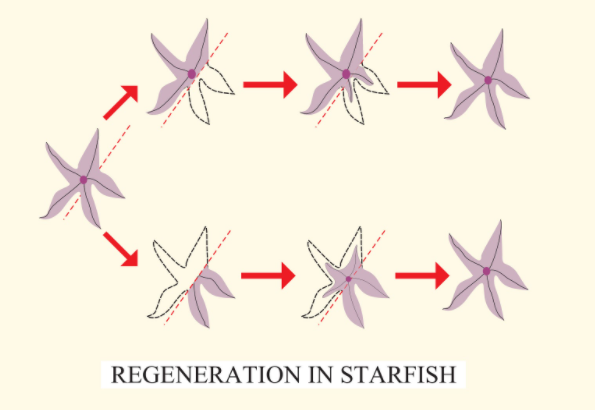
If starfish is cut into pieces, each piece grows into a complete animal. The process is called
(a) Regeneration
(b) Reproduction
(c) Healing of the wound
(d) Growth
Answer
557.1k+ views
Hint: It is one aspect of the general process of growth, is a primary attribute of all living systems. Without it, there may be no life, for the very upkeep of a life form relies on the relentless turnover by which all tissues and organs continually reestablish themselves.
Complete answer:
Regeneration is the process that is defined as the reconstruction of outer appendages and internal organs that got injured, which can be caused by self or can be external. The injury is quickly trailed by complete, effective re-growth of the lost parts. The regeneration process is present in most starfish.
Additional Information: A few cases are so obviously versatile that they have developed components for regeneration, yet systems for self-removal, as though to misuse the regenerative capacity. The process of losing a part spontaneously is called autotomy. The division of a protozoan into two cells and the parting of a worm into equal parts might be viewed as instances of autotomy. Some pioneer marine creatures called hydroids shed their upper segments occasionally.
In some cases the part that becomes back isn't equivalent to that which was lost, and, periodically, recovery might be instigated without having lost anything by any means. It isn't phenomenal for a regenerated part to be inadequate. Earthworms, for instance, usually regenerate only five segments within the anterior direction albeit quite that number are amputated. Many insects regenerate abnormally small legs from which some segments could also be missing.
So the correct answer is ‘Regeneration’.
Note: Tadpole tails when amputated grow back to about only half their original length. These and other cases testify to the very fact that a touch regeneration is usually good enough—that it's not necessary in every case to breed a flawless copy of the original.

Complete answer:
Regeneration is the process that is defined as the reconstruction of outer appendages and internal organs that got injured, which can be caused by self or can be external. The injury is quickly trailed by complete, effective re-growth of the lost parts. The regeneration process is present in most starfish.
Additional Information: A few cases are so obviously versatile that they have developed components for regeneration, yet systems for self-removal, as though to misuse the regenerative capacity. The process of losing a part spontaneously is called autotomy. The division of a protozoan into two cells and the parting of a worm into equal parts might be viewed as instances of autotomy. Some pioneer marine creatures called hydroids shed their upper segments occasionally.
In some cases the part that becomes back isn't equivalent to that which was lost, and, periodically, recovery might be instigated without having lost anything by any means. It isn't phenomenal for a regenerated part to be inadequate. Earthworms, for instance, usually regenerate only five segments within the anterior direction albeit quite that number are amputated. Many insects regenerate abnormally small legs from which some segments could also be missing.
So the correct answer is ‘Regeneration’.
Note: Tadpole tails when amputated grow back to about only half their original length. These and other cases testify to the very fact that a touch regeneration is usually good enough—that it's not necessary in every case to breed a flawless copy of the original.

Recently Updated Pages
Master Class 12 Business Studies: Engaging Questions & Answers for Success

Master Class 12 Economics: Engaging Questions & Answers for Success

Master Class 12 English: Engaging Questions & Answers for Success

Master Class 12 Maths: Engaging Questions & Answers for Success

Master Class 12 Social Science: Engaging Questions & Answers for Success

Master Class 12 Chemistry: Engaging Questions & Answers for Success

Trending doubts
What is meant by exothermic and endothermic reactions class 11 chemistry CBSE

Which animal has three hearts class 11 biology CBSE

10 examples of friction in our daily life

One Metric ton is equal to kg A 10000 B 1000 C 100 class 11 physics CBSE

1 Quintal is equal to a 110 kg b 10 kg c 100kg d 1000 class 11 physics CBSE

Difference Between Prokaryotic Cells and Eukaryotic Cells




